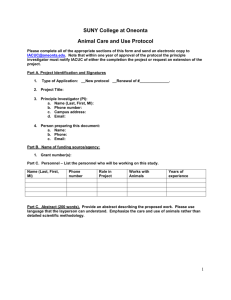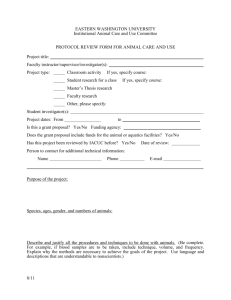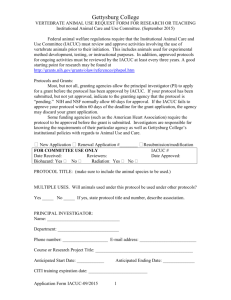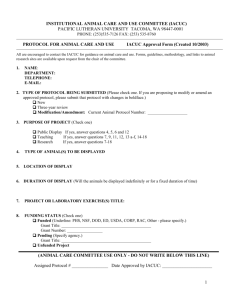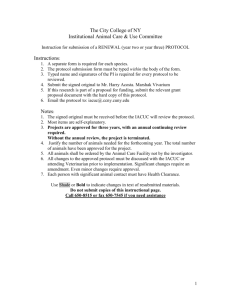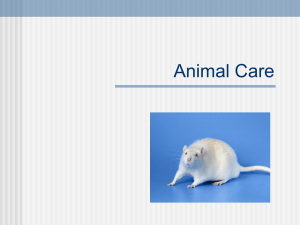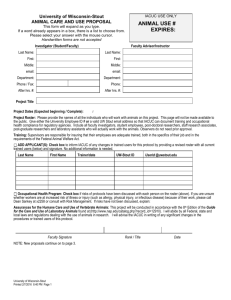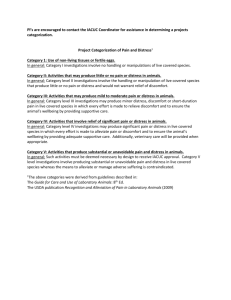Animal Protocol Summary Form (AUG 2014)
advertisement
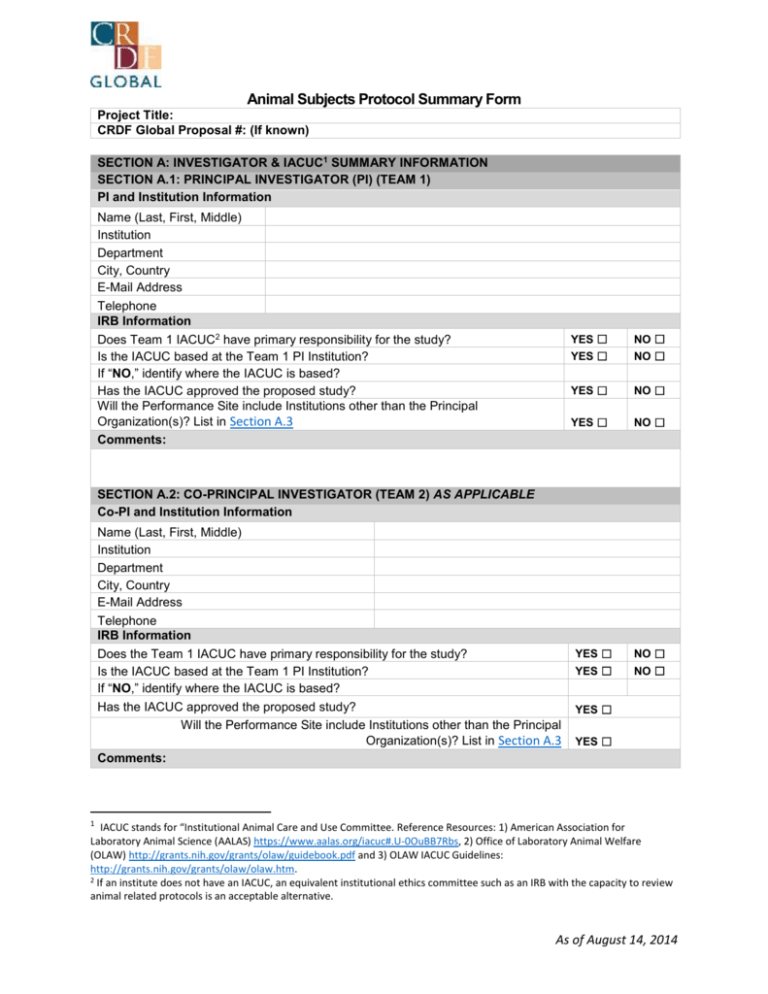
Animal Subjects Protocol Summary Form Project Title: CRDF Global Proposal #: (If known) SECTION A: INVESTIGATOR & IACUC1 SUMMARY INFORMATION SECTION A.1: PRINCIPAL INVESTIGATOR (PI) (TEAM 1) PI and Institution Information Name (Last, First, Middle) Institution Department City, Country E-Mail Address Telephone IRB Information Does Team 1 IACUC2 have primary responsibility for the study? Is the IACUC based at the Team 1 PI Institution? If “NO,” identify where the IACUC is based? Has the IACUC approved the proposed study? Will the Performance Site include Institutions other than the Principal Organization(s)? List in Section A.3 Comments: YES ☐ NO ☐ YES ☐ NO ☐ YES ☐ NO ☐ YES ☐ NO ☐ SECTION A.2: CO-PRINCIPAL INVESTIGATOR (TEAM 2) AS APPLICABLE Co-PI and Institution Information Name (Last, First, Middle) Institution Department City, Country E-Mail Address Telephone IRB Information Does the Team 1 IACUC have primary responsibility for the study? Is the IACUC based at the Team 1 PI Institution? If “NO,” identify where the IACUC is based? Has the IACUC approved the proposed study? Will the Performance Site include Institutions other than the Principal Organization(s)? List in Section A.3 Comments: YES ☐ NO ☐ YES ☐ NO ☐ YES ☐ YES ☐ 1 IACUC stands for “Institutional Animal Care and Use Committee. Reference Resources: 1) American Association for Laboratory Animal Science (AALAS) https://www.aalas.org/iacuc#.U-0OuBB7Rbs, 2) Office of Laboratory Animal Welfare (OLAW) http://grants.nih.gov/grants/olaw/guidebook.pdf and 3) OLAW IACUC Guidelines: http://grants.nih.gov/grants/olaw/olaw.htm. 2 If an institute does not have an IACUC, an equivalent institutional ethics committee such as an IRB with the capacity to review animal related protocols is an acceptable alternative. As of August 14, 2014 SECTION A.3: PERFORMANCE SITES List all collaborating and performance sites: 1. 2. If other than above Principal Institution(s), list name and contact information of performance site(s): (replicate table for additional sites) Institution Address Main Contact Name Contact Phone Contact E-Mail Study tasks to be performed at site: SECTION B: RESEARCH SCOPE SECTION B.1: SUMMARY OF PROPOSED RESEARCH Summarize the proposed research using non-technical language that can be understood by persons whose primary concerns are nonscientific. I. Brief statement of the purpose, background, significance, research design, and methods: II. III. Description in non-scientific terms of how animals will be used. Include all manipulations and procedures (including dietary manipulations). This description should provide an understanding of what happens to an animal from the time of acquisition/interaction to the endpoint of the activity. Description of the rationale for using animals for this activity. Could this study be done without using animals? SECTION B.2: PROJECT CHARACTERISTICS Will investigator(s) intervene or interact with a living animal subject(s) to obtain specimen or other information? If yes, list directly involved investigators: 1. 2. 3. 4. YES ☐ Does the research involve (check all that apply): 1. Research involving live animals maintained in a laboratory setting (Complete Section C.1) 2. Research involves field study on live domesticated animals from a farm, slaughterhouse or other monitored setting? (Complete Section C.2) NO ☐ ☐ ☐ As of August 14, 2014 3. Research involves field study on live wild animals (Complete Section C.2) ☐ 4. Research involves animal euthanasia for research or teaching purposes (Complete Section D.5) ☐ 5. Research involves observational study of live animals (non-invasive) ☐ 6. Research involves invasive collection for research purposes of biological specimens (Complete Section D.1) 7. Research procedures have potential to cause pain or distress, or discomfort to animals (Complete Section D.2) 8. Research involves substance administration (including implants and devices) (Complete Section D.3) 9. Research involves surgery (Complete Section D.4) 10. Research will include euthanasia and/or disposal of animals after use (Complete Section D.5) ☐ ☐ ☐ ☐ ☐ SECTION C: ANIMAL STUDY ENVIRONMENT Animal Selection. Provide the following information for all animals. No animal should be listed more than once; count each in the highest proposed category of use. Add rows as needed. * For field studies involving capture methods, anticipated non-target (by catch) species should also be indicated by species or in aggregate as “miscellaneous.” ** Give ranges if the specific information is unknown. *** Please choose from the following sources: commercial vendor, collected from the wild, third party owned, or other (provide details). **** See Appendix A Species Age and (include common Weight** name)* Source*** Category of use**** Total Number Requested SECTION C.1: USE OF LIVE ANIMALS IN A LABORATORY SETTING (As applicable – If indicated in Section B.2) I. Description of the appropriateness of the species to be used. II. How did you determine the number of animals to be used in this study? III. Who will be responsible for animal care and maintenance? Describe the type of training they have received. As of August 14, 2014 SECTION C.2: USE OF LIVE ANIMALS IN A FIELD SETTING (As applicable – If indicated in Section B.2) I. Description of the appropriateness of the species to be used. II. How did you determine the number of animals to be used in this study? III. Who will be responsible for handling animals in the field? Describe the type of training they have. SECTION D: CARE AND USE OF ANIMALS (As applicable – If indicated in Section B.2) SECTION D.1: Invasive sample collection from live animals (blood/urine/feces/tissue/other) Species Sample Site(s) of Sample Collection Method(s) Volume(s) Frequency of Collection Provide details for any sample collection procedures that may not be clear from this table. SECTION D.2: Potential Pain and Distress I. List each procedure or condition with potential for pain, distress, or discomfort, and give the species and number of animals affected. Describe the clinical signs or abnormalities that are expected or possible. II. Describe the monitoring plan for pain and distress, including frequency and duration of checking for health or behavioral abnormalities. III. Describe how pain, distress, and discomfort will be minimized, consistent with scientific objectives under the following conditions, as applicable. Include the actions to be taken, and the specific criteria/endpoints for euthanasia, if applicable. (Examples include not eating for >24 hours, loss of >15% of normal body weight, self-mutilation, non-weight bearing for >24 hours, etc.) As of August 14, 2014 a. If painful or distressful procedures or conditions are relieved with anesthesia, analgesia, tranquilization, or other therapies: (1) For each species to be used, list procedure or condition in which methods will be used. Provide drug, dose, route, frequency of administration, and anticipated duration of therapeutic effect. Include all medications, such as pre- and postanesthetics, antibiotics, paralytics, etc. (If applicable, describe surgery in next section.) Species Procedure or condition Agent Dosage, route Frequency Duration (2) Describe monitoring procedures to ensure adequacy and safety of anesthesia or tranquilization. (3) Describe monitoring procedures for recovery from anesthesia or tranquilization. b. If painful or distressful procedures or conditions will NOT be relieved with anesthesia, analgesia, tranquilization, other palliative therapies or humane endpoints, please explain why. c. If death is intended to serve as an experimental endpoint (i.e., if animals must be allowed to die from an experimental condition or procedure), please explain why this experimental endpoint is necessary for the study. IV. If physical restraint (defined as more than 1 hour) will be used, describe physical restraint methods. How will potential distress be minimized (e.g. sedation, acclimation/training)? V. If trapping or other method of capture will be used in field studies, describe methods. Explain how pain, distress, and discomfort are minimized. As of August 14, 2014 VI. Exceptions to standards: Describe and justify any exceptions to federal (U.S. Government) regulations or standards and give the species of animal and number to be used. (Examples of exceptions: use of an animal in more than one protocol involving a major operative procedure from which it is allowed to recover; deprivation of food or water; maintaining animals at temperatures and/or humidity outside the ranges specified by the standards; not cleaning and/or sanitizing at required frequencies; not providing diurnal lighting as required; not meeting space requirements; exceptions from the exercise plan for dogs.) VII. Consideration of Alternatives. If there are procedures or conditions that may potentially cause more than momentary or slight pain or distress (by definition, this includes all Category D and E studies outlined in Appendix A.), were alternatives considered? Yes No "Alternative" refers to methods, models, and approaches that result in the reduction of the number of animals used, that incorporate refinements of procedures which result in the lessening of pain or distress to animals, or that provide for the replacement of animals with non-whole animal systems or the replacement of one animal species with another, particularly if the substituted species is non-mammalian or invertebrate. If Yes, list Alternatives and describe methods and sources consulted to determine availability or appropriateness of alternatives for this protocol. SECTION D.3: Substance Administration I. Will anything be administered to, implanted in, or will devices be used on animals? YES NO II. If YES, list specific agents below and provide dosage information (mg/kg body weight and volume), unless provided in Section B.3. Radioisotopes? List/dosage: ______________ Pathogenic or viable organisms? List/dosage: ______________ Toxic chemicals? List/dosage: ______________ Carcinogens? List/dosage: ______________ Transplantable tumors*? List/dosage: ______________ Biological materials such as tissue, sera, or cell lines*? List/dosage: ______________ Recombinant DNA? List/dosage: ______________ Others not listed above, including implants or devices*? List/dosage: ______________ *If materials have been derived or passed through rodent species, they must be free of infectious agents (Mouse Antibody Production [MAP]/Rat Antibody Production [RAP]/Hamster Antibody Production [HAP] testing are diagnostic assays used as indicators of viral contamination of rodent products). III. For each of the above, describe in detail the precautions taken to protect people and animals in the environment, including handling practices for contaminated excreta, bedding and toxic metabolites. IV. Describe the effects of these agents on the experimental animal. Potential for pain or distress should be addressed in SECTION D.2. As of August 14, 2014 SECTION D.4: Surgery I. Surgery and postoperative monitoring and records must be in accordance with IACUC (or relevant animal care and use body) guidelines. II. Will surgery be survival or non-survival*? *(animal does not recover from anesthesia prior to euthanasia) Survival Non-Survival III. Describe in detail the surgical procedure(s) for each species to be used. Include description of presurgical preparation and method of closure, if applicable. IV. If the animal will recover from anesthesia, how long will the animal be maintained after recovery? V. Describe in detail the postoperative care, including any specialized care. VI. Will individual animals undergo more than one surgical procedure? Yes No If yes, provide scientific justification below. SECTION D.5: Euthanasia/Disposition I. Provide the following information for all planned/experimental euthanasia of animals. Complete Section D.5.VI. (below) if animals will not be euthanized as part of these planned animal use activities. . Species Method/agent Dosage, Route II. How will death be confirmed? observation for 20 minutes bilateral thoracotomy cervical dislocation after administration of euthanasia (drug, carbon dioxide, etc.) other – please describe: As of August 14, 2014 III. If applicable, justify methods that vary from the American Veterinary Medical Association Guidelines on Euthanasia (http://www.avma.org/issues/animal_welfare/euthanasia.pdf). Physical methods such as gunshot, decapitation and cervical dislocation also require scientific justification. IV. If these animals are not to be euthanized as part of your protocol, what will become of them? V. Describe in detail the postoperative care, including any specialized care. SECTION E: DOCUMENTATION & REVIEWS Please submit or plan to obtain the follow documentation applicable to your study: Documentation Status/Comments IACUC application (or equivalent ethics committee approval) IACUC (or equivalent ethics committee approval) approval letter or form Certificate of Training use and care of animals involved in Research As of August 14, 2014 Appendix A Pain and Distress Categorization USDA Reporting: CFR Ch.1, 2.36(b)(5-7) Category B Animals being bred, conditioned, or held for use in teaching, testing, experiments, research, or surgery but not yet used for such purposes. Category C Teaching, research, experiments, or tests conducted involving no pain, distress, or use of pain relieving drugs Examples Category D Category E Experiments, teaching, research, experiments, or tests conducted involving accompanying pain or distress to the animals and for which appropriate anesthetic, analgesic, or tranquilizing drugs were used Teaching, experiments, research, surgery, or tests conducted involving accompanying pain or distress to the animals and for which the use of appropriate anesthetic, analgesic, or tranquilizing drugs would have adversely affected the procedures, results, or interpretation of the teaching, research, experiments, surgery, or tests. Examples Examples Standard agricultural husbandry procedures (Ag Guide 1999) not for research, teaching or testing. 1. Holding or weighing animals in teaching or research activities. 1. Diagnostic procedures such as laparoscopy or needle biopsies. 1. Research or procedures that require continuation until death occurs. 2. Euthanasia to relieve pain and/or distress 2. Non-survival surgical procedures. Standard animal health programs. i.e. routine physical examinations, vaccinations, etc. 3. Injections, blood collection or catheter implantation via superficial vessels. 3. Survival surgical procedures, including biopsies and cut-downs for catheter placement. 2. Application of noxious chemicals or stimuli (e.g., electrical shock) if the animal cannot avoid/escape the stimuli, and/or it is severe enough to cause pain or distress. 1. Pre-weaning methods of identification (toe or tail clipping, tattooing, wing banding, ear notching, etc.) 4. Teaching routine physical examinations. 5. Observation of animal behavior. 6. Feeding studies that do not result in clinical health problems. 7. Humane euthanasia procedures that meet AVMA standards. 8. Live trapping with minimal potential for injury. 4. Postoperative pain or distress is alleviated. 5. Ocular blood collection in mice. 6. Exsanguinations under anesthesia. 7. Induced infections with appropriate anesthesia and post-op/postprocedure analgesia when necessary. 3. Novel prolonged restraint 4. Exposure to extreme environmental conditions. 5. Prolonged withholding of food and water. 6. Infectious or neoplastic disease studies involving unrelieved pain or distress. 9. Chemical immobilization or restraint 10. Studies involving clinical signs not judged to involve more than slight pain or distress. As of August 14, 2014
